How to Keep Your Children Safe at the Pool This Summer and All Year Long
According to the latest statistics from the Centers for Disease Control (CDC), approximately 10 people die from unintentional drowning each day. Among them, two are children age 14 and younger, accounting for about one in five drowning deaths overall. Every parent worries about swimming danger, but parents of children with disabilities may be even more concerned about pool safety.
We’ve put together this guide to cover all the safety tips parents of children with disabilities need to know to keep their kids safe in and around swimming pools this summer, whether you have a backyard swimming pool or you’re heading to the local community pool for a fun, refreshing afternoon. Most of the safety tips you’ll find below apply to children with all types of disabilities (and many also to children without disabilities), but we’ve included specific tips most applicable for children with certain types of disabilities as well. Above all, common sense reigns supreme, and as a parent, you know your child and his or her needs better than anyone. Use that knowledge to your advantage to keep your child safe this summer at the pool.
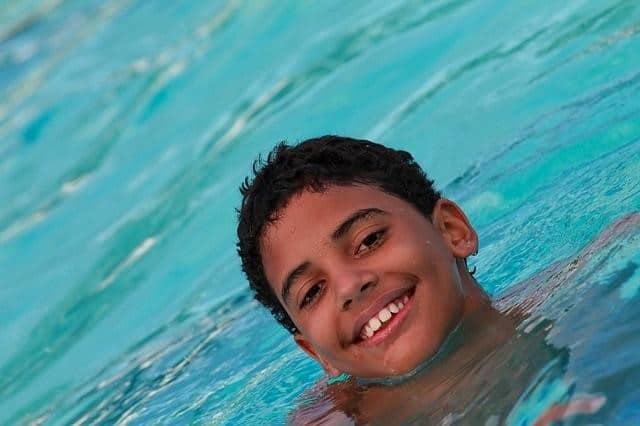
Image via Pixabay by wilkernet
What You’ll Find In This Guide:
- General Pool Safety Tips for Parents of Disabled Children
- Pool Safety Tips for Children with Autism or Sensory Processing Disorders
- Pool Safety Tips for Children with ADHD
- Pool Safety Tips for Children with Down Syndrome
- Pool Safety Tips for Children with Cerebral Palsy and Other Physical Disabilities
- Resources on Pool Safety for Children with Disabilities
General Pool Safety Tips for Parents of Disabled Children
This section outlines some general pool safety tips, such as choosing the right sun protection, preventing dehydration, and keeping an eye on children at all times.
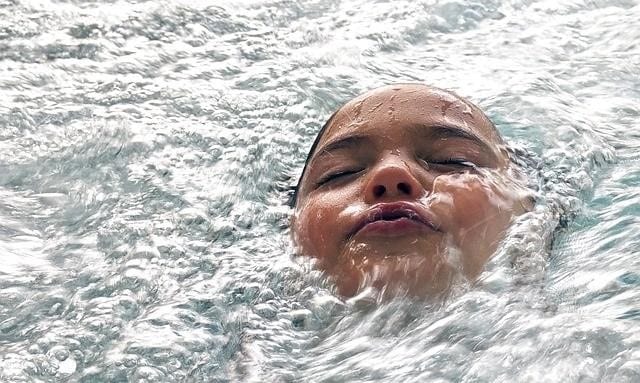
Image via Pixabay by eLaba
Children with disabilities may not understand the risks associated with water, so it’s imperative that a parent or responsible adult keep an eye on the child at all times – even if they’re in the shallow end. Make sure that your child is playing appropriately and safely; intervene immediately if you notice inappropriate behavior such as hitting.
Make sure your child is well-hydrated. Swimming is a physically exerting activity, yet people don’t notice that they’re sweating in the pool because they can’t see it. Children may also be too busy having fun to think about being thirsty, yet dehydration can be a real concern on a hot day at the pool. That means you’ll need to remind your child regularly to take a break to rehydrate.
Be sure to slather on the sunscreen. Spending some time in the sun is a great way to get some vitamin D, but harsh UV rays can quickly lead to a sunburn, which can not only increase the risk of skin cancer but is also quite an unpleasant experience, particularly for children with disabilities. You’ll also want to ensure your child is lathered up with the right sun protection:
- Choose a sunscreen made for children.
- Check the label to make sure it blocks harmful UV rays.
- Look for sunscreen with SPF 15 or greater.
- Apply 15 to 30 minutes before going outside.
- Reapply every one to two hours.
Pool Safety Tips for Children with Autism or Sensory Processing Disorders
This section covers important pool safety tips for children with autism, which should be followed in addition to the general pool safety advice provided above.
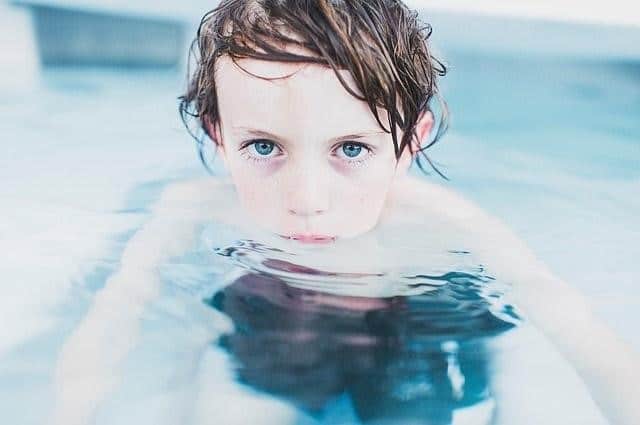
Image via Pixabay by Pexels
For children with autism or those with sensory processing disorders, it’s important to introduce them early to the experience of playing safely in the water. Expose your child to water at a young age so that they become comfortable in and around it.
Sign your child up for swimming lessons at a young age. Some organizations offer swimming lessons specifically for children with special needs, so find out if one of these programs is available in your area.
If your child has autism or sensory issues, they may not like the sensation of wearing a floatation device or lifejacket, so keep a watchful eye to ensure that your child doesn’t remove these safety devices. Be patient, but ensure that your child is able to play safely in the pool.
Some children with Autism Spectrum Disorder (ASD) are drawn to water. If this is a characteristic of your child, and you have a backyard swimming pool or live near one, make sure that the pool is equipped with working gates, alarms, pool covers, and locks to prevent unsupervised entry. This may mean getting cooperation from your neighbor who has a pool in his or her backyard, but in most cases, homeowners want their friends and neighbors to be safe.
Use visual cues and social stories to communicate pool safety. Many children with autism are visual learners, so using visual pictures and other cues to communicate the steps to getting ready for the pool, safe swimming practices, and other rules can be an effective way to educate your child about pool safety. Additionally, using social stories with favorite characters can help your child prepare for various situations he or she may encounter at a public swimming pool.
Pool Safety Tips for Children with ADHD
Swimming can be an especially beneficial activity for children with ADHD, but that doesn’t mean there aren’t safety concerns. While many of the safety tips for children with autism apply to children with ADHD as well, there are a few important safety strategies parents of children with ADHD can use to prepare their child for a safe, fun day at the pool.
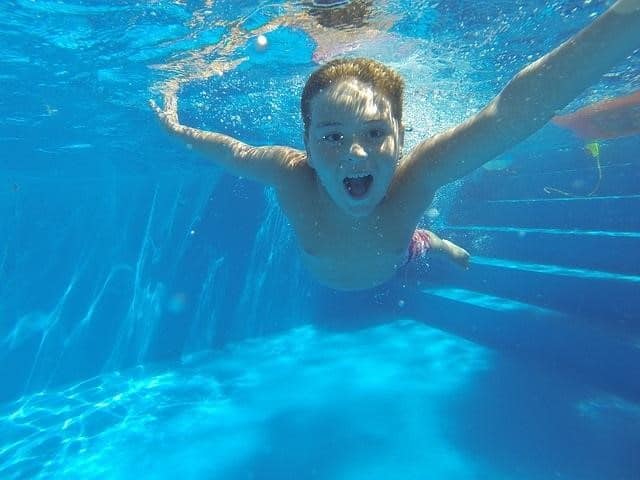
Image via Pixabay by Pexels
Swimming lessons are helpful for kids with ADHD in more ways than one. In addition to enhancing their safety in and around water, swimming lessons provide opportunities for social interaction, enable kids with ADHD to release energy, and often provide a more distraction-free learning environment compared to other types of activities. Swimming can also help children with ADHD find focus.
Children with ADHD may need to practice appropriate behaviors before going to the pool. Role-playing rules and swimming activities can be helpful for preparing your child for the social scene at a public pool or a friend’s backyard pool.
Keep an eye out for impulsivity and inappropriate behavior. Inattentiveness can also be a concern while swimming. Your child may need to be reminded of the rules frequently while at the pool, or he or she may need to take frequent breaks from the activity to decompress.
Pool Safety Tips for Children with Down Syndrome
Children with Down syndrome have varying levels of disability, which may include both physical and intellectual limitations. Delayed motor skill development, weak muscle tone and strength, and other challenges can make it difficult for children with Down syndrome to engage in certain physical activities. This section provides tips and advice for improving pool safety for children with Down syndrome.
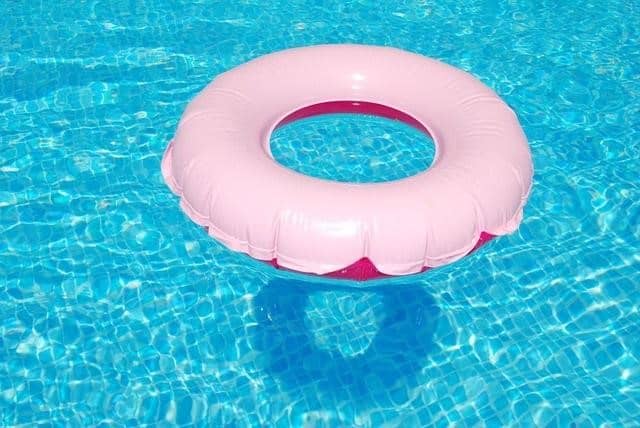
Image via Pixabay by Merio
Children with Down syndrome should be given opportunities to develop and refine motor skills, even though they may be behind their peers in skill development. Therefore, parents may find success in gradually introducing their child to swimming, building skills over time to enforce safety and comfort.
If your child is scared of the water, encourage – but don’t force – him or her to watch others swimming in the pool. Over time, children who are initially frightened often gain an interest in swimming through the act of watching others participating in the activity; they may simply need more time to get comfortable with the water.
Focus on basic water skills first, such as breathing, floatation, and moving underwater, before introducing the concept of swimming strokes. Expect your child to follow the rules like anyone else and provide plenty of encouragement and support, but be patient when explaining and reinforcing the rules.
Pool Safety Tips for Children with Cerebral Palsy and Other Physical Disabilities
There are a variety of other disabilities that affect children, from cerebral palsy to other physical disabilities, both congenital and acquired through accident or injury. This section provides tips for enhancing pool safety for children with cerebral palsy and other physical limitations.
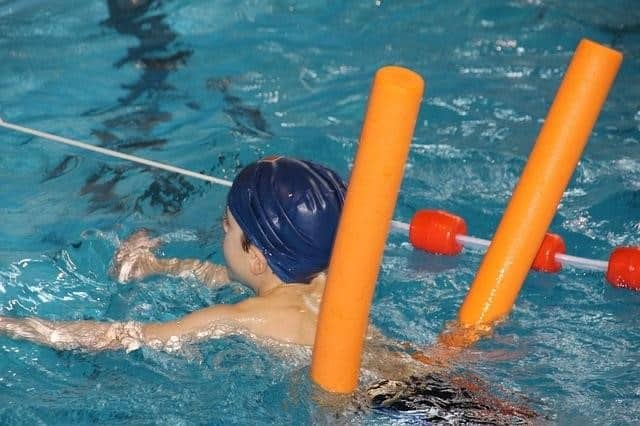
Image via Pixabay by TaniaVdB
Swimming is an exceptionally beneficial activity for children with cerebral palsy and other types of physical disabilities. The water can help tense muscles relax, and provide freedom of movement to children with paralysis or who have limited use of their limbs. However, as these children often experience uncontrolled and involuntary movements, constant supervision is essential for safety.
Use adaptive equipment. Children with physical disabilities often enjoy the independence of being able to move freely in the water with the aid of a floatation device but without the assistance of another person. Adaptive devices range from life jackets to floating mats, pool noodles, arm bands, backpack-style floats, swim rings, and more.
Swimming lessons are a safety measure for children with physical disabilities, too. Look for swimming programs with knowledgeable staff who are experienced in adapting lessons to meet the needs of children with physical disabilities. It may not be possible for your child to swim completely independently, but they can learn how to be comfortable in the water and navigate safely around a swimming pool.
Resources on Pool Safety for Children with Disabilities
This section includes additional resources on pool safety for children with disabilities, including general pool safety information, accident prevention, resources on specific disabilities, adaptable sports, and more.
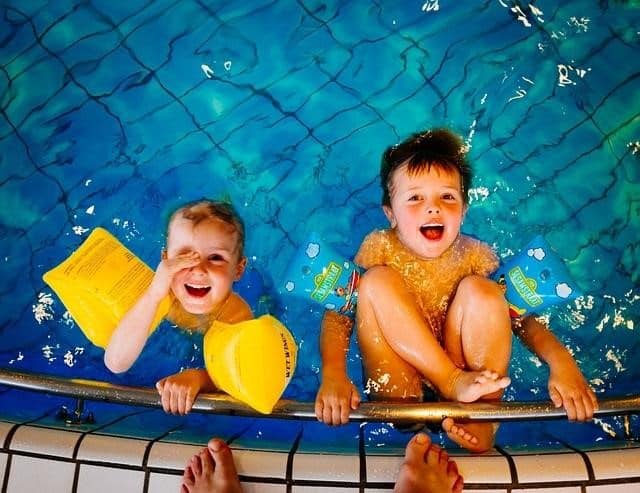
Image via Pixabay by tookapic
The American Red Cross provides a comprehensive list of water safety tips for all children, including supervision, what to do in an emergency, and more.
Love That Max features a useful guide identifying the different types of swimming aids that work well for children with disabilities.
NCHPAD outlines the many important benefits swimming provides for both children and adults with disabilities.
Move Forward discusses several adaptive sports for people with disabilities. In addition to swimming, this resource discusses golf, cycling, horseback riding, and other sports that are adaptable to meet an individual’s unique needs.
HopeTree Care discusses the benefits of aquatic therapy for people with disabilities, and also outlines useful safety gear and swimming aids, including the use of prosthetics designed to mimic the buoyancy of real legs in the water.
The US Department of Justice, Civil Rights Division has published a guide outlining the requirements under the Americans with Disabilities Act related to the acceptable means of entry and exit for accessible pools.
HydroWorx provides an in-depth guide on aquatic therapy, including a full list of conditions that can benefit from water therapy, benefits, the safety of aquatic exercises, and much more.
Human Kinetics has published a book excerpt on the benefits of adapted aquatics, which discusses the importance of remembering that each person is unique when conducting aquatics lessons.
CerebralPalsy.org has an informative article on swimming for children with cerebral palsy, including the results of research demonstrating substantial improvement in gross motor function in as little as six weeks.
PVSwim.org offers an in-depth guide for coaches on including swimmers with disabilities, which provides information on specific, actionable steps for how to include disabled swimmers, and much more.



 United States
United States Canada
Canada